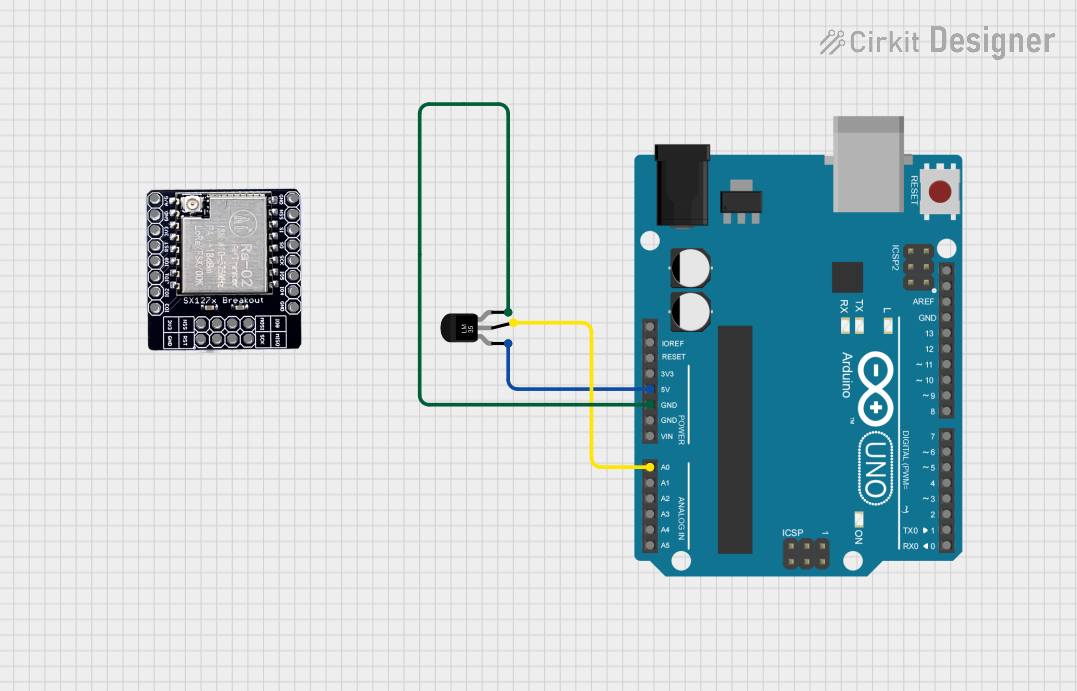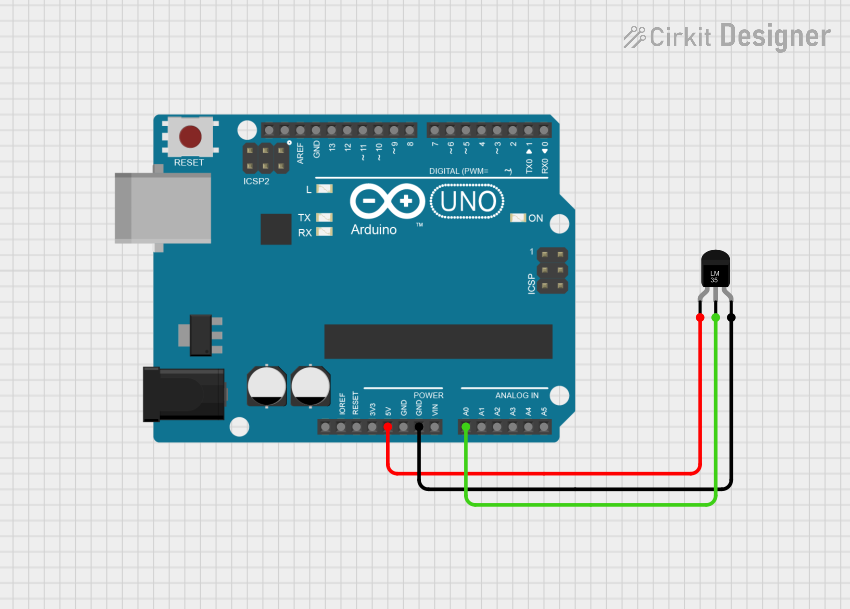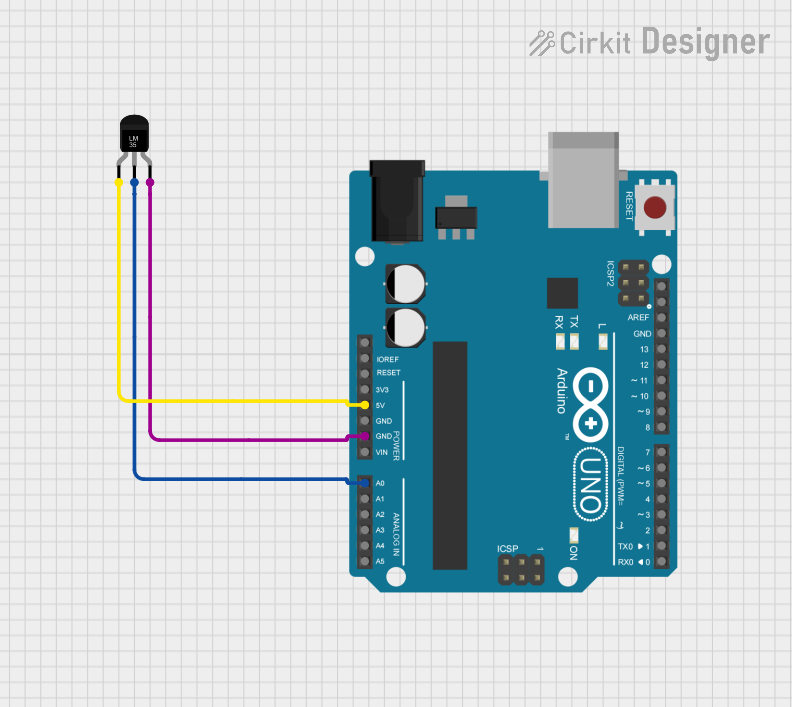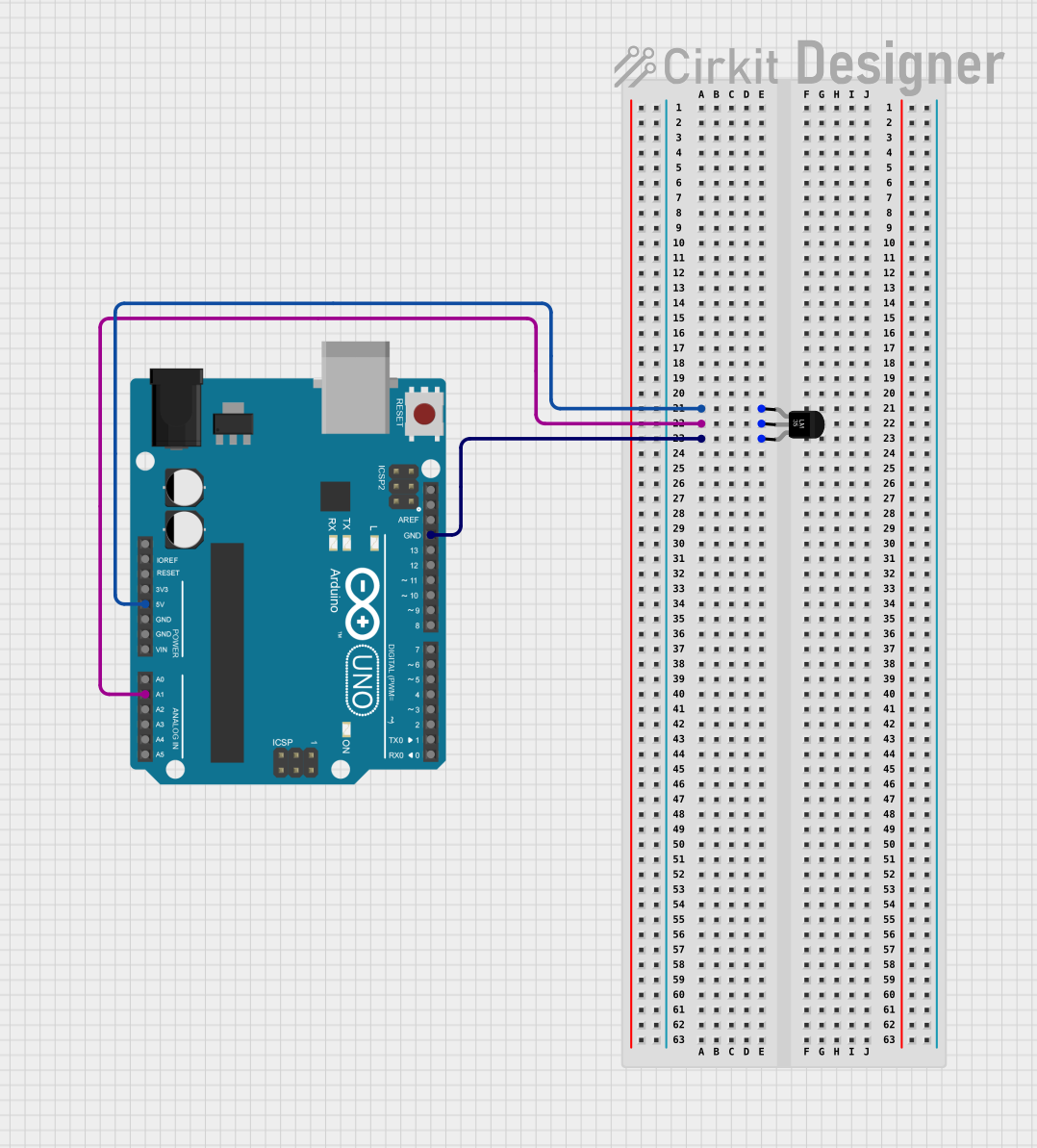
How to Use LM35 Temperature Sensor: Examples, Pinouts, and Specs

 Design with LM35 Temperature Sensor in Cirkit Designer
Design with LM35 Temperature Sensor in Cirkit DesignerIntroduction
The LM35 is a precision temperature sensor manufactured by Texas Instruments, with the part ID LM35. It provides an output voltage directly proportional to the temperature in degrees Celsius, making it an ideal choice for temperature monitoring and control applications. Unlike thermistors, the LM35 does not require any external calibration or trimming, ensuring high accuracy and reliability. Its linear output and ease of interfacing with microcontrollers make it a popular choice for a wide range of projects.
Explore Projects Built with LM35 Temperature Sensor

 Open Project in Cirkit Designer
Open Project in Cirkit Designer
 Open Project in Cirkit Designer
Open Project in Cirkit Designer
 Open Project in Cirkit Designer
Open Project in Cirkit Designer
 Open Project in Cirkit Designer
Open Project in Cirkit DesignerExplore Projects Built with LM35 Temperature Sensor

 Open Project in Cirkit Designer
Open Project in Cirkit Designer
 Open Project in Cirkit Designer
Open Project in Cirkit Designer
 Open Project in Cirkit Designer
Open Project in Cirkit Designer
 Open Project in Cirkit Designer
Open Project in Cirkit DesignerCommon Applications
- HVAC systems for temperature monitoring and control
- Weather stations and environmental monitoring
- Industrial process control
- Consumer electronics, such as thermostats
- Medical devices for temperature measurement
Technical Specifications
The LM35 is designed to operate over a wide range of temperatures and provides a simple analog output. Below are its key technical details:
| Parameter | Value |
|---|---|
| Supply Voltage (Vcc) | 4V to 30V |
| Output Voltage Range | 0V to 1.5V (for 0°C to 150°C) |
| Temperature Range | -55°C to +150°C |
| Accuracy | ±0.5°C (at 25°C) |
| Output Sensitivity | 10mV/°C |
| Current Consumption | 60 µA (typical) |
| Load Impedance | ≥ 10 kΩ |
Pin Configuration and Descriptions
The LM35 is available in a 3-pin TO-92 package (commonly used) and other package types. Below is the pinout for the TO-92 package:
| Pin Number | Pin Name | Description |
|---|---|---|
| 1 | Vcc | Positive power supply (4V to 30V) |
| 2 | Vout | Analog output voltage proportional to temperature |
| 3 | GND | Ground (0V reference) |
Usage Instructions
The LM35 is straightforward to use in a circuit. Follow the steps below to integrate it into your project:
Connecting the LM35
- Power Supply: Connect the Vcc pin (Pin 1) to a stable DC voltage source between 4V and 30V.
- Ground: Connect the GND pin (Pin 3) to the ground of your circuit.
- Output: Connect the Vout pin (Pin 2) to an analog input pin of your microcontroller or to a voltmeter for direct measurement.
Important Considerations
- Decoupling Capacitor: Place a 0.1 µF ceramic capacitor between Vcc and GND to filter out noise.
- Load Impedance: Ensure the load impedance on the Vout pin is at least 10 kΩ to maintain accuracy.
- Temperature Range: Operate the sensor within its specified temperature range (-55°C to +150°C) for reliable performance.
- Output Voltage: The output voltage is 10mV per degree Celsius. For example, at 25°C, the output voltage will be 250mV.
Example: Interfacing LM35 with Arduino UNO
Below is an example of how to connect and read temperature data from the LM35 using an Arduino UNO:
Circuit Diagram
- Connect the LM35's Vcc pin to the Arduino's 5V pin.
- Connect the GND pin to the Arduino's GND pin.
- Connect the Vout pin to the Arduino's analog input pin (e.g., A0).
Arduino Code
// LM35 Temperature Sensor Example with Arduino UNO
// Reads temperature in Celsius and prints it to the Serial Monitor
const int sensorPin = A0; // Analog pin connected to LM35 Vout
float temperatureC; // Variable to store temperature in Celsius
void setup() {
Serial.begin(9600); // Initialize serial communication at 9600 baud
}
void loop() {
int sensorValue = analogRead(sensorPin); // Read analog value from LM35
float voltage = sensorValue * (5.0 / 1023.0); // Convert to voltage (5V reference)
// Calculate temperature in Celsius (10mV per degree Celsius)
temperatureC = voltage * 100.0;
// Print temperature to Serial Monitor
Serial.print("Temperature: ");
Serial.print(temperatureC);
Serial.println(" °C");
delay(1000); // Wait 1 second before next reading
}
Best Practices
- Avoid placing the LM35 near heat sources or in direct sunlight to prevent inaccurate readings.
- Use proper shielding and grounding in noisy environments to minimize interference.
- For long-distance connections, use shielded cables to reduce signal degradation.
Troubleshooting and FAQs
Common Issues and Solutions
No Output Voltage:
- Ensure the power supply is within the specified range (4V to 30V).
- Check all connections, especially the ground connection.
Inaccurate Temperature Readings:
- Verify that the load impedance on the Vout pin is at least 10 kΩ.
- Place a decoupling capacitor (0.1 µF) between Vcc and GND to reduce noise.
- Ensure the sensor is not exposed to external heat sources or airflow.
Fluctuating Output:
- Check for loose connections or unstable power supply.
- Use a capacitor to stabilize the output voltage.
FAQs
Q1: Can the LM35 measure negative temperatures?
A1: Yes, the LM35 can measure temperatures below 0°C. However, the output voltage will be negative, so additional circuitry (e.g., an op-amp) may be required to read negative values.
Q2: Can I power the LM35 with 3.3V?
A2: The LM35 requires a minimum supply voltage of 4V. For 3.3V systems, consider using a level shifter or a different temperature sensor compatible with 3.3V.
Q3: How do I convert the output voltage to Fahrenheit?
A3: Use the formula:
Temperature (°F) = (Temperature (°C) × 9/5) + 32
For example, if the output voltage corresponds to 25°C, the temperature in Fahrenheit is:
(25 × 9/5) + 32 = 77°F.
By following this documentation, you can effectively integrate the LM35 temperature sensor into your projects and troubleshoot common issues with ease.